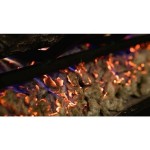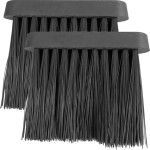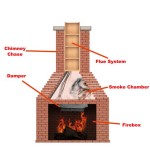Brick Hearth Ideas for a Timeless Fireplace Centerpiece
The fireplace is often regarded as the heart of a home, a gathering place that provides warmth, comfort, and a focal point for social interaction. A critical component of any fireplace setup is the hearth. The hearth serves not only as a protective barrier against stray embers and sparks but also as an aesthetic element that can significantly enhance the overall look and feel of the fireplace. Brick, with its inherent durability and classic appeal, remains a popular choice for hearth construction. This article will explore various brick hearth ideas, focusing on design options, brick types, and installation considerations.
The decision to use brick for a fireplace hearth is driven by several factors. First, brick offers excellent heat resistance, a vital characteristic for a component designed to withstand the high temperatures associated with fires. Second, brick is a relatively low-maintenance material, requiring minimal upkeep to maintain its appearance and structural integrity. Third, brick provides a timeless aesthetic that complements a wide range of architectural styles, from traditional to contemporary. The versatility of brick, both in terms of color and texture, allows for a high degree of customization. Finally, from a practical standpoint, brick is generally an affordable and readily available material, making it an accessible option for homeowners.
Enhancing Aesthetics with Brick Patterns
One of the most effective ways to personalize a brick hearth is through the selection of a specific brick pattern. The pattern determines the visual arrangement of the bricks and contributes significantly to the overall style of the fireplace. Several common brick patterns are well-suited for hearth applications, each offering a distinct aesthetic. These choices allow for a great deal of design flexibility, matching the preferences of the homeowners and the characteristics of the space where the fireplace is located.
The running bond pattern, characterized by staggered courses of bricks, is a classic and simple choice. It is relatively easy to install and provides a clean, uniform appearance. This pattern is highly versatile and works well with various brick colors and textures. Its simplicity makes it well-suited for both traditional and modern settings. The staggered alignment creates visual interest without being overwhelming. The running bond is also structurally sound due to its even distribution of weight.
The herringbone pattern, featuring bricks laid in a V-shaped arrangement, offers a more intricate and visually dynamic look. This pattern is often used to create a focal point and add a touch of sophistication to the fireplace. While more complex to install than the running bond, the herringbone pattern creates a striking aesthetic that draws the eye. It is particularly well-suited for larger hearths where the pattern can be fully appreciated. This particular pattern often looks best with a monochromatic palette, such as a single shade of red or grey brick.
The basket weave pattern, which arranges bricks in alternating squares, provides a unique geometric design. This pattern offers a balanced and symmetrical appearance, making it suitable for formal settings. The basket weave pattern provides a more handcrafted or artisan look to the hearth with its interwoven appearance. Often, contrasting colors are used within the design to further highlight the pattern. The regularity of the pattern makes it easy to maintain and clean.
The stack bond pattern, where bricks are laid directly on top of each other with aligned joints, creates a modern and minimalist aesthetic. This pattern emphasizes the clean lines and geometric shapes of the bricks. This particular pattern works best with very precise, uniformly sized bricks. Some may perceive this design as too simple, while others appreciate its pared-down modern aesthetic. The pattern can be enhanced through the use of colored grout or decorative brick variations.
In addition to these common patterns, homeowners can explore more custom or unique arrangements. For example, creating a border around the perimeter of the hearth using a different brick color or pattern can add visual interest and define the space. Incorporating decorative brick inserts or medallions can also personalize the hearth and reflect individual style preferences. Consult with a professional mason to explore the feasibility of implementing more complex or unconventional patterns.
Selecting the Right Brick Type
The type of brick used for a hearth significantly impacts its appearance, durability, and heat resistance. Different brick types possess varying characteristics in terms of composition, manufacturing process, and performance properties. Understanding these differences is crucial for selecting the right brick for a specific fireplace application. Careful consideration of brick type ensures that the hearth will withstand the demands of fire exposure and complement the overall design of the fireplace.
Clay brick, the most common type of brick, is made from a mixture of clay and shale fired at high temperatures. Clay bricks are widely available in various colors, textures, and sizes. They offer good heat resistance and durability, making them a suitable choice for hearth construction. Clay bricks may be further classified as either face bricks or common bricks. Face bricks are typically used for exterior applications and offer a more refined appearance, while common bricks are often used for structural purposes and may have a rougher texture.
Firebrick, designed specifically for high-temperature applications like fireplace linings and hearths, is made from refractory clay that can withstand extreme heat without cracking or deteriorating. Firebricks offer superior heat resistance compared to standard clay bricks. They are often used in direct contact with the firebox to protect the surrounding structure from heat damage. While generally more expensive than standard clay bricks, firebricks provide the necessary protection for high-heat environments. They’re usually a light tan or cream color.
Paver bricks, typically used for walkways, patios, and driveways, are also suitable for hearth construction. Paver bricks are designed to withstand heavy loads and resist weathering. They may be made from clay, concrete, or other materials. Paver bricks often come in a variety of shapes and sizes, allowing for creative design possibilities. While not specifically designed for high-temperature applications, paver bricks can provide adequate heat resistance for hearths that are not in direct contact with the firebox. Concrete pavers can be susceptible to surface spalling, so consider proper sealing.
Reclaimed brick, sourced from demolition sites or old buildings, offers a unique and weathered appearance. Reclaimed bricks add character and history to a fireplace hearth. The irregularities and imperfections of reclaimed bricks contribute to a rustic or vintage aesthetic. However, it is important to inspect reclaimed bricks carefully for structural integrity and contaminants. Ensure that the reclaimed bricks are clean and free of any harmful substances before using them for hearth construction. The use of reclaimed bricks can also add to the uniqueness of a home renovation project.
When selecting brick for a hearth, consider the color and texture of the brick. The color should complement the surrounding décor and architectural style. The texture can add visual interest and character. Smooth bricks offer a clean and modern look, while rough or textured bricks provide a more rustic or traditional feel. Also, consider the size and shape of the bricks. Larger bricks can create a more substantial and monolithic appearance, while smaller bricks allow for more intricate patterns. Ultimately, the brick type should be selected based on a combination of aesthetic preferences and functional requirements.
Important Installation Considerations
Proper installation is critical to ensure the longevity, safety, and performance of a brick hearth. The installation process involves preparing the subfloor, laying the bricks, and applying mortar. A well-executed installation will result in a durable and aesthetically pleasing hearth that will provide years of service. Conversely, a poorly installed hearth can lead to structural problems, safety hazards, and costly repairs. Adhering to established best practices is essential for a successful installation.
The subfloor must be level and capable of supporting the weight of the brick hearth. If the subfloor is uneven or weak, it must be reinforced or replaced before installing the bricks. A concrete slab or a reinforced wooden platform can provide a stable foundation for the hearth. Ensure that the subfloor is clean and free of debris before proceeding with the installation. A level subfloor helps ensure a smooth and even surface for the brick hearth.
A mortar bed provides a bonding agent to adhere the bricks to the subfloor and each other. The mortar bed should be of a consistent thickness to ensure a level surface. Use a mortar mix specifically designed for masonry applications. Apply the mortar evenly to the subfloor and the back of each brick. Carefully position the bricks according to the chosen pattern, leaving a consistent joint spacing between the bricks. Use a level to ensure that the bricks are aligned correctly. Mortar joints are critical to the stability of the hearth structure.
Grouting fills the joints between the bricks, creating a watertight seal and enhancing the appearance of the hearth. Choose a grout color that complements the brick color and style. Apply the grout evenly to the joints, using a grout float to press the grout into the gaps. Remove excess grout with a damp sponge. Allow the grout to cure according to the manufacturer's instructions. Properly grouted joints prevent water penetration and enhance the overall durability of the hearth.
Sealing helps to protect the brick and grout from moisture, stains, and damage. Apply a sealant specifically designed for masonry surfaces. Choose a sealant that is appropriate for the type of brick and grout used. Apply the sealant evenly to the entire surface of the hearth. Allow the sealant to dry according to the manufacturer's instructions. A properly sealed hearth will be easier to clean and maintain. It's important to choose a sealant that won't alter the appearance of the brick.
When undertaking a brick hearth installation, consider consulting with a professional mason. A mason can provide expert advice on brick selection, pattern design, and installation techniques. A professional installation will ensure that the hearth is structurally sound, aesthetically pleasing, and compliant with local building codes. Experienced masons are familiar with the intricacies of brickwork and can avoid common pitfalls that could compromise the integrity of the hearth.

Red Brick Fireplace Ideas Beautiful Designs Fireplaces Decor

35 Gorgeous Natural Brick Fireplace Ideas Part 2

40 Brick Fireplace Ideas Captivating Showstoppers With Timeless Charm Makeover White

Our Ugly Brick Fireplace He Vetoes Painting It Laurel Home

Stone Fireplace Hearth Ideas Brick Decor Red Fireplaces

Brick Fireplace Design Installation Scarlett Fireplaces
:strip_icc()/101901958-ca10f847d8b54a8d9bb2222d39cd960c.jpg?strip=all)
Best Fireplace Hearth Ideas And Designs Tips

16 Red Brick Fireplace Makeover Ideas

Designer For Cape Cod Kitchen Remodel In Kansas City Fireplace Herringbone Surrounds

Antique Brick And White Molding Fireplace Makeover Maison De Pax
Related Posts








